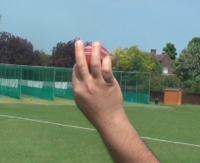Field Settings: Leg Spin, Tail Ender and Set Batsman
This article is part of "The complete guide to cricket field settings" series.
Imagine a game situation where you have a tail-end batsman at one end, and a well-set batter at the other end. It makes senses to spend more time bowling at the weaker player. You are more likely to get a wicket.
The trouble is that the set batsman will do everything he can to stay on strike by hitting boundaries in the over then stealing a single on the last ball.
You don't want to defend this tactic alone as you still want to try to bowl both players out. But you also want to stop the boundary shots.
So you set an in-out field.
Bowlers: How to Make Your Mark Before you Bowl a Ball
Preparation for the bowlers at the start of the innings often relies on stretching and a few practise balls, with the marking of the run-up left to necessity at the last minute.
Something my team started to do was to get the whole bowling attack to mark their run-ups together from both ends.
How to Open the Bowling with Spin
We might think of it as a bold and innovative IPL-style tactic, but spinners have been opening the effectively bowling for years. Yet it’s still under-used in club cricket.
In my mind there is a place for defying convention and opening with spin. You just have to know who, when and how.
So, as a spinner, when might you be called on to bowl the first over of the innings?
You Don’t Need Every Variation to Be an Excellent Spin Bowler
Mushtaq Ahmed, Graeme Swann, Syd Barnes and Shane Warne: Each player a unique and world-class spin bowler of his time.
None of them used every variation in the book.
They didn’t need them all. They maintain their deception by varying the angle of spin within a small region either side of their stock delivery.
4 (+2) Tools All Spinners Can Use to Get Wickets
In part one we looked at the art of flight, in this part we expand on the theory to show you how to use different ways to flight the ball to get wickets.
When you combine topspin and backspin with subtle changes of pace you have four new tools with which to dismiss the batsman:
The Art of Flight: How to Deceive the Batsman with More than Spin
What spin bowler hasn't heard these clichés in his cricketing career?
"Toss it up" the young spin bowler is so often told. "You've got to flight the ball, give it some air, and get it above the batsman's eye line".
Cricket Show 101: All the Gear, No Idea
| Attachment | Size |
|---|---|
| PitchVision Academy - PitchVision Academy Cricket Show 101.mp3 | 24.78 MB |
 Burners reveals his mantra for batting and slow left arm bowling success this week. Meanwhile David bemoans bad teas and rants about fast bowlers with a lazy attitude.
Burners reveals his mantra for batting and slow left arm bowling success this week. Meanwhile David bemoans bad teas and rants about fast bowlers with a lazy attitude.
Where Do High Class Spinners Pitch the Ball?
In another guest article, club left arm spinner AB talks us through exactly where to land the ball to cause maximum damage to batsmen’s averages.
We all know the key to top quality spin bowling is to bowl a consistent line and length. But what does that actually mean?
First we need to figure out where is the best length to bowl.
We want a length that is full enough that the batsman is forced to come forward, but not so full that he is able to reach the ball on the half volley without mis-hitting it.
Don’t Miss Your Chance for Free Leg Spin Advice
Do you bowl or coach leg spin? Do you want to improve your skills?
If you said ‘yes’ to that you want to act fast because I’m about to close both offers of free leg spin advice.
As you know I have been giving away free leg spin videos and articles to celebrate the launch of online coaching courses by Mohammed Haroon, our leg spin coach.
But we can’t do it forever so we are giving you a last chance to:
Become a Classy Leg Spin Bowler (Even if You Don’t Have a Coach)
 Something tells me you don’t have a good leg spin coach where you play, but that still doesn’t stop you bursting to get better as a leg spinner.
Something tells me you don’t have a good leg spin coach where you play, but that still doesn’t stop you bursting to get better as a leg spinner.
You have got a grip on the basics. You have played enough games to know what’s going on. But you don’t know what to do next.
In other words, you are stuck in a rut and don’t have anyone to turn to.

